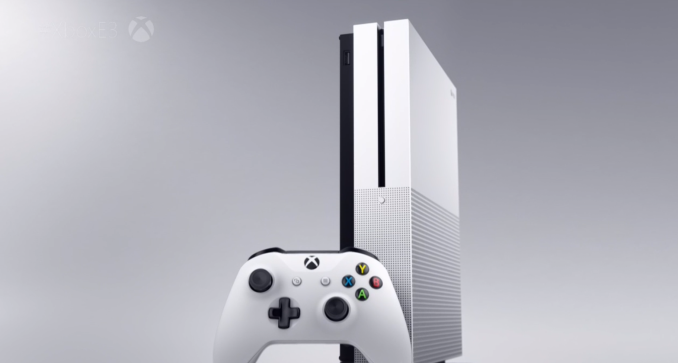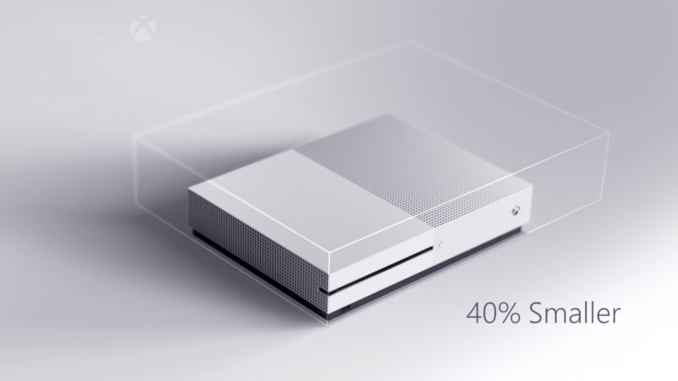Microsoft Announces Xbox One S Console: A Slimmer Design
by Ian Cutress on June 13, 2016 12:30 PM EST
Today at the annual Electronic Entertainment Expo (E3), Microsoft has lifted the lid on their new Xbox One console design. The Xbox One is part of the eighth generation of consoles, and was originally released in November 2013. The new Xbox One S is assumed to have similar hardware inside, however the design is taking up 40% less volume. Typically when a device changes in volume this much, as with previous generations that have launched slimmer designs, inside there will be a processor on a smaller process node and optimized for power for the same performance. This allows a smaller more efficient design, and in this case Microsoft has integrated the power supply into the console, negating the need for a large power brick.
Other highlights for the launch include HDR and 4K output support, although it is unspecified if this is through HDMI 2.0 or DisplayPort. The main thing here is for streaming video from services such as Netflix, Amazon and Hulu rather than running games at 4K. Theoretically it also means that the video outputs can offer enough bandwidth for some of the virtual reality headsets on the market/coming to market. The new Xbox One S will support HDR as well, suggesting that it must also support HDMI 2.0a or DisplayPort 1.4. HDMI 2.0a is more likely, as DisplayPort which isn't part of the original Xbox design and would suggest that the SoC has been adjusted to support it. Though for consistency we would assume that the core GPU architecture is the same, and is more likely to be HDMI 2.0a. As mentioned by nathanddrews in the comments, HDMI 2.0a can't support 10-bit 4:4:4 chroma like DisplayPort 1.4, which is what we would expect on a PC-like interface, but it it does do 10-bit in 4:2:0 chroma, which is what we would expect for games and film.
The controller for the Xbox One is also new, featuring a redesigned textured grip on the rear and what looks like at an attempt to improve the ergonomics. The Xbox One Elite Controller was released a while back at $150, but the new controller is designed to mimic the one originally released with the Xbox One. The new controller will be available for worldwide purchase for $60, and now supports Bluetooth for connection to PCs so that USB dongles are not needed. The controllers should still use WiFi Microsoft's proprietary wireless communication technology to Xbox One as standard, as these controllers need to work with the original Xbox One consoles.
The Xbox One S can support up to 2 TB of a hard disk drive, suggesting that in the console space having more capacity (for games as well as downloaded shows) is more important than solid state storage. There will be 500GB and 1TB editions as the main set, with 2TB being a special launch edition.
At $299, the One S comes in at the same price as the original Xbox One 500GB console with a one-game bundle when we compare prices on Amazon. In fact, checking the press release shows that $299 is the 500GB edition of the One S, a 1TB model at $349, and the 2TB Special Edition will be available in certain markets at $399 starting from early August. Additionally, the official Xbox One Vertical Stand will be on sale for $20.
When it was first launched, the expected lifetime of a the console generation was around five to seven years, which means that we currently sit in the middle of that timeframe, and if a manufacturer was going to offer an updated model, this would be it. Updating a console design mid-generation is nothing new, we’ve seen it as far back as the original Playstation, however this generation has an additional issue: with everyone talking about VR, no-one is confident that the current generation of consoles is up to the task. So it will be interesting to see how the new Xbox One S will play in this space, now that the video output is up to the task.
Source: Microsoft at E3






















58 Comments
View All Comments
Michael Bay - Monday, June 13, 2016 - link
You sound exactly like the bern victims do.inighthawki - Monday, June 13, 2016 - link
I'm not really sure where you're going with that one...djsvetljo - Monday, June 13, 2016 - link
:). See, you take those things as granted, as status quo. I don't. A CPU socket changes every 2 years not because it has to. It changes because there are people like you (and me as well) to buy the newer "all you ever need (untill next year) " item. If crazy means different - please call me crazy.JoeyJoJo123 - Monday, June 13, 2016 - link
You're crazy.Eden-K121D - Monday, June 13, 2016 - link
Yeah we need a Unified standard with low latency high bandwidth connection for Uncompressed 8K 60Hz with 4:4:4 chroma subsampling withoutweilin - Tuesday, June 14, 2016 - link
Remember Intel's Socket T (LGA 775)? That lasted from 2001 all the way to 2008! One, second let me take my rose colored glasses off... I remember that socket, and I (a 20something) remember just how confusing it was. the original i85x chipsets only supports 90nm processors. the Later generation i9xx series chipsets supported 65nm Pentium 4s. But certain 945 and 975 boards were potentially BIOS upgradeable to support the latest Core 2 CPUS! Which ones? better look closely because only some have the voltage regulator hardware to do it! 965 series chipsets supported all the 90nm and 65nm stuff! Then came the 3x and 4x series chipsets which dropped support for 90nm CPUs (some board did), but gained support for 45nm CPUs (only the 4x series officially, but some 3x series were compatible with a BIOS update).The best part of all this was, a CPU bought from 2001 could fit in a motherboard bought in 2008! It just didn't do anything... The reverse was also possible, a CPU bought in 2008 also fit in a 2001 board... Only if you tried that, the board would supply 45nm CPU voltage (1.2v) with 90nm CPU voltage (1.6v?) and instantly kill it...
Intel was practically switching sockets every 2 years... Only they kept the socket the same and caused all sorts of confusion on what worked together and what didn't. Sometimes with expensive consequences... Socket changes is the cost of technological progress.
weilin - Tuesday, June 14, 2016 - link
Why isn't there an edit feature...I remember certain 945/975 boards frying the first generation 65nm Core 2s, I remember waiting patiently for the 965 boards to come out so I didn't have to risk it. No, I don't miss those days...
WinterCharm - Monday, June 13, 2016 - link
Took a leaf out of apples book, I see.Wolfpup - Monday, June 13, 2016 - link
"Updating a console design mid-generation is nothing new, we’ve seen it as far back as the original Playstation"Actually I'm almost certain the Atari VCS/2600 had multiple revisions. I know for a fact the NES did (and Master System, Turbographix, Genesis, SNES, etc., etc., etc.)
This looks like a nice update, and I find it super attractive looking-BUT I want a user replaceable hard drive!
djsvetljo - Monday, June 13, 2016 - link
I hear XBox Scorpio Slim Founders Super Charged Dollar Edition will have user replaceable hard drive. It will also be the latest and best 2.3" (two point three) form factor with Sata enhanced (reversed pins) magnetic connector.